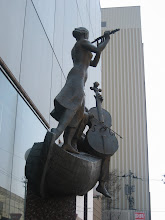This is my third attempt at a round back book. I like how they look when correctly done and I plan to make more of them, with a teacher so I don't screw up too badly.
This is A5 in size, hard cover, of course, sewn on chords, and using brown paper that has been aged via the old trick of setting the pages on fire. And putting them out, too, of course. It is a little over 200 pages and includes the 1831 edition of Mary Shelley's Frankenstein (via Gutenberg.org) plus an introductory essay about female authors in the 19th century.
Also included are pictures of the authors, Percy, and a variety of people related to the Shelley's such as Clair Clairmont. Plus drawings and photos of the monster, Frankenstein, and other movie stills.
In addition, this is my first attempt at making real headbands instead of the glue on kind. This headband is simplified: a piece of book cloth (used on the spine) glued to a piece of string (used as the cords the text block was sewed to) and sewed into the head and tail of the spine. I like it and will attempt a two-thread headband next. I hope.




























